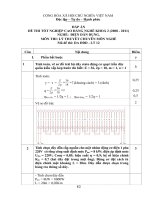PASSAGE 12
Bạn đang xem bản rút gọn của tài liệu. Xem và tải ngay bản đầy đủ của tài liệu tại đây (44.49 KB, 2 trang )
PASSAGE 12
For years, drivers only had to fear the risk of a speeding ticket from an officer with a radar gun.
Then came speed cameras that automatically mailed drivers tickets. Now, yet another trend is emerging:
Speed caps, in which a vehicle's software restricts an engine or motor from accelerating past a
predetermined threshold, are being built into cars, e-scooters and e-bikes to improve safety. Volvo, which
invented the modern seatbelt in the 1950s, is pushing ahead with the caps as part of its 2020 goal to end
deaths and serious injuries in Volvos. Earlier this month, the company announced it would electronically
limit its new sedans and SUVs to drive no more than 112 mph.
Road safety advocates, who for years have warned that speeding raises the same dangers as
drunk driving, are heartened by the changes. However, they say there's still much work to do, such as
convincing the public that speeding is a serious issue that needs to be addressed. Additionally, some
critics question whether a cap will actually improve safety. "A cap at that speed is meaningless," said Alex
Engel, a spokesman for the National Association of City Transportation Officials. "A vehicle traveling at
112 mph will still be a threat to people on city streets should an accident happen."
But perhaps the largest impact of speed limiting is already playing out in micromobility, a term
for person-sized vehicles such as electric bikes and electric scooters that have become popular in the last
year. However, scooter companies say speed limits can make it difficult for riders to keep up with the
flow of traffic and may encourage them to ride illegally on the sidewalk, a location where they won't be
surrounded by cars and trucks that move much faster. Jonathan Freeman, a 66-year-old San Diego
resident, worries the rise of micromobility will make sidewalks unsafe. He's organized a group called Safe
Walkways that lobbies local and state legislature for regulations of e-scooters. "We're all in fear of this
coming summer when the tourists come back in overwhelming numbers, which means more people
misbehaving and using these vehicles inappropriately," Freeman said.
Some road experts say addressing scooter safety needs to be part of a larger conversation about
speed. Jurisdictions that have required electronic speed limits to be built into electric scooters and bikes
haven't made the same request of shared cars. "Your biggest threat as a pedestrian or bicyclist isn't a
scooter. It's a traditional car," said Jonathan Adkins, executive director of the Governors Highway Safety
Association, adding that there are about 10,000 speed-related car and truck deaths every year. "But for
whatever reason these scooters and new mobility devices have drawn everyone's attention."
(Adapted from )
Question 1. Which of the following best serves as the titel for the passage?
A. Raising Awareness About The Issue of Speeding is Essential.
B. Road Experts Raising Concerns About Micromobility.
C. In The Future, Your Vehicle May Determine How Fast You Travel Itself.
D. New Speed Limiting Technology Reduces Traffic Congestions.
Question 2. What can be inferred from the first paragraph?
A. Officers with radar guns have been replaced by automatic speed cameras and speed caps.
B. Drivers are now more afraid of speed caps than of automatic speed cameras.
C. The company Volvo is focusing on improving the safety of its products.
D. By 2020, no one will die or be injured in sedans and SUVs.
Question 3. The word “threshold” in paragraph 1 most likely means ___________.
A. level
B. rule
C. status
D. order
Page 1
Question 4. The word “them” in the second paragraph refers to __________.
A. Scooter companies B. Riders
C. Speed limits
D. Cars and trucks
Question 5. From what Alex Engel said in paragraph 2, it can be inferred that __________.
A. he is afraid that implementing speed caps may lead to more accidents.
B. he believes that the level of safety won’t actually change for the better, even with speed caps in
operation.
C. he doesn’t think that speed caps are capable of limiting a car’s speed to under 112 mph.
D. he is of the opinion that vehicles traveling at 112mph should be banned because they are a major
threat.
Question 6. The word “overwhelming” in the fourth paragraph is closest in meaning to ___________.
A. confusing
B. surprising
C. great
D. horrifying
Question 7. Which of the following is TRUE about speed limiting in micromobility?
A. It may have some unwanted effects.
B. It has become well-known in the last year.
C. It can have a negative impact on tourism.
D. It leads to an increase in the number of cars and trucks.
Question 8. Which of the following statements can be inferred from the passage?
A. Many people are now aware of the fact that speeding is just as dangerous as drunk driving.
B. Many companies like Volvo will implement speed limiting technology by 2020.
C. People are paying too much attention to imposing speed limits on cars and trucks.
D. The emphasis of speed limiting should not be put on scooters and bikes alone.
ĐÁP ÁN
1-C
2-C
3-A
6-C
7-A
8-D
4-B
5-B
Page 2









